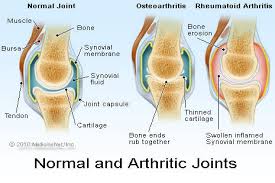Blogs Details

JOINT PROBLEM
Arthritis
Osteoarthritis
Join pain
Osteoporosis etc
arth - joint
itis – inflammation
Arthritis – inflammation of the joint's
Arthritis Facts-
on disability.
Control and Prevention projects that the
number of Americans over 65 who
suffer from osteoarthritis will double to 41 million by 2030.
Osteoarthritis-
There are more than 100 different types of arthritis. The most common type is called osteoarthritis, which is sometimes known as degenerative joint disease (DJD). It is most often the result of normal “wear and tear” and occurs to some extent in all people as they age.
Joints Affected by Osteoarthritis-
Hip
Knee
Spine
All joints can be effected, however, the most commonly involved are the weight bearing joints such as the hip, knee and spine. They must withstand the significant forces generated by walking and running, and therefore are prone to wearing out.
What are Joints?
Joints are the places where the bones meet. The body would be immobile if not for the movements afforded by the joints. Joints can be large or small, and permit movements as varied as walking, bending, reaching, and performing fine motor skills.
Hip joint-
The hip is a simple ball and socket joint. The upper end of the thigh bone (femur) is the ball. It fits snugly into the socket, a part of the pelvis called the acetabulum.
Knee Joint-
The knee is the largest joint in the body, and one of the most easily injured. It is made up of the lower end of the thighbone (femur) which rotates on the upper end of the shinbone (tibia), and the knee cap (patella) which slides in a groove on the end of the femur.
Cartilage-
Within the joints, the ends of the bones are covered with a smooth, white, glistening material called hyaline cartilage. When normal, this material cushions the underlying bone against excessive pressure and allows the joint to move easily and without pain.
When the articular cartilage is damaged or injured, it usually goes through a staged process of softening, flaking, fragmenting, and finally complete loss, where the underlying bone is exposed. This process is commonly known as osteoarthritis or OA.
Menisci-
ØCrepitis (grinding)
ØJoint Deformity
ØOsteophytes
ØJoint Stiffness
Joint Pain and Stiffness
osteoarthritis are painful and stiff joints.
lasting less than 30 minutes.
Creaking or Grinding Sounds
Crepitis is the medical term for the grinding sound often heard when attempting to move the affected joint
t Sometimes moving the joint through the full normal range of motion may not even be possible
Joint Deformity-
The arthritic knee joint can develop a deformity in which the joint itself becomes angled
Valgus deformity is the term used to describe what many people commonly refer to as being “knock kneed.”
Varus deformity is the term used to describe what is referred to as being “bowlegged.”
Osteophytes-
Joints also may appear swollen, caused by new bony growths called osteophytes (bone spurs) or sometimes, by extra fluid in the joint.
How is Arthritis Diagnosed?
ØSigns and symptoms
ØHistory and physical examination
ØX-Rays
ØBlood Tests
ØAnalysis of Joint Fluid
Treating Arthritis-
ØAlthough there is no cure for osteoarthritis, proper treatment can help relieve the symptoms and prevent or correct serious joint problems.
Ø
ØThere are two general classes of treatments, surgical and nonsurgical.
ØAlthough there is no cure for osteoarthritis, proper treatment can help relieve the symptoms and prevent or correct serious joint problems.
Ø
ØThere are two general classes of treatments, surgical and nonsurgical.
1. Health and behavior modifications - physical therapy, exercise, weight loss.
2. Drug therapy – Pain relievers, NSAIDs, COX2 inhibitors
3. Intra-articular injections – steroids, viscosupplementation
1. Arthroscopy - Day surgery, done through small holes
2. Arthroplasty - Total Joint Replacement
NSAIDs-NSAIDs – Non Steroidal Anti-inflammatory Drugs
Ø NSAIDs are first line therapy drugs that are used to both relieve pain and to decrease inflammation.
Ø Some examples of NSAIDs are Motrin, Feldene, and Indocin.
Ø Many people cannot take NSAIDs because of there side effects including GI upset and an increased risk of bleeding
Intra-articular Injections-
There are two main types of intra-articular injections.
1. Steroids – Injected into the joint to decrease inflammation.
2. Viscosupplementation – Injected into the joint to provide lubrication